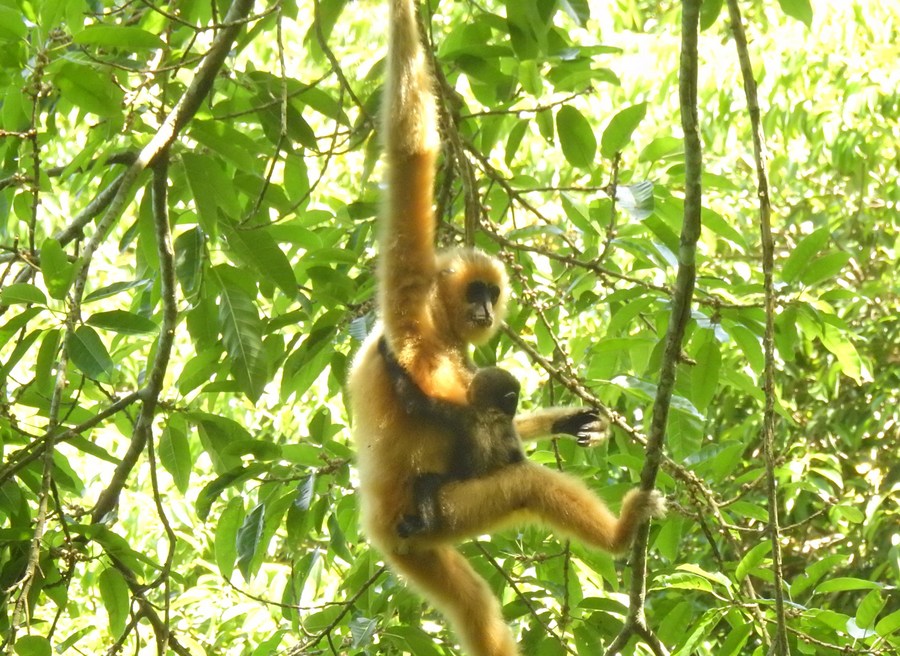COP15: National park system highlights China's nature conservation efforts

Aerial photo taken on May 25, 2021 shows a view of Ngoring Lake at the source of the Yellow River section of the Sanjiangyuan National Park in northwest China's Qinghai Province. (Xinhua/Li Zhanyi)
BEIJING, Oct. 13 (Xinhua) -- China on Tuesday officially designated the first group of national parks, a move to further improve the national park system amid the country's efforts of nature conservation.
Home to nearly 30 percent of the key terrestrial wildlife species found in China, the parks that include the Sanjiangyuan National Park, the Giant Panda National Park, the Northeast China Tiger and Leopard National Park, the Hainan Tropical Rainforest National Park, and the Wuyishan National Park cover a protected land area of 230,000 square km. Each park represents a typical ecological function.
Starting in 2015, China has launched 10 pilot national parks. The first pilot project was kicked off in Sanjiangyuan (Three-River-Source) area, home to the headwaters of the three rivers of Yangtze, Yellow and Lancang. It boasts 69 wildlife species under state protection, accounting for 26.8 percent of the country's total.
At an average altitude of more than 4,700 meters, the Sanjiangyuan National Park in northwest China is the world's highest national park covering a total area of 190,700 square km.
Establishing a national park system is an innovative policy design for China, with the purpose of restoring natural habitats and protecting endangered species.
Wang Xiangguo, head of the Sanjiangyuan National Park administration, hailed the initiative as a great pioneering work in building China's ecological civilization.
The tangible outcomes are a result of years of hard work. Compared with a decade ago, water conservation in the Sanjiangyuan area rose 6 percent on average annually, with grassland coverage jumping over 11 percent and grass output increasing 30 percent, official data showed.
Amid efforts to improve wildlife habitats and conserve the ecosystems, populations of several rare and endangered species have gradually recovered in national parks.

Photo taken in May, 2021 shows a Hainan gibbon and its baby ape in south China's Hainan Province.(Hainan Tropical Rainforest National Park/Handout via Xinhua)
Early last month, the administration of Hainan Tropical Rainforest National Park announced that two baby apes had been spotted, bringing the population of wild Hainan gibbons to 35.
The national park spans nine cities and counties in south China's Hainan Province, covering a total area of over 4,000 square km. It is home to the most concentrated and well-preserved tropical rainforests in China and is the only habitat of Hainan gibbons, a rare primate in the world.
Huang Jincheng, director of the park administration, said the spotting of the two baby apes shows that Hainan gibbons are in good breeding condition, their living environment and conditions are steadily improving, and the natural ecological spaces have been restored and expanded.
In 2017, China began piloting a national park dedicated to the protection of giant pandas, the country's national treasure. The Giant Panda National Park stretches through Sichuan, Shaanxi and Gansu provinces.
The population of wild giant pandas in the cross-provincial national park is stable, with their habitats expanding and becoming more connected. Several migration corridors have been built and monitoring devices have been installed.
Thanks to conservation efforts, the at-risk status of wild giant pandas has been downgraded from "endangered" to "vulnerable," as their population has grown to some 1,800.
Experts believe that giant pandas have become an "umbrella species" whose protection helps more than 8,000 kinds of rare animals and plants including golden monkeys, snow leopards and Chinese yews.
Protecting giant pandas has a wider significance. The Giant Panda National Park has shouldered more responsibilities such as promoting ecological governance and human-nature harmony, said Li Sheng, a researcher with Peking University and a specialist in bears.
The harmonious coexistence between human and nature may become the most outstanding feature of China's national parks, noted Yang Rui, director of the institute for national parks of Tsinghua University in Beijing.
National parks are a millennium plan that will benefit the present and future generations, and they will play an important role in protecting the biological and cultural diversity of the planet as well as easing the crisis posed by climate change, Yang said.